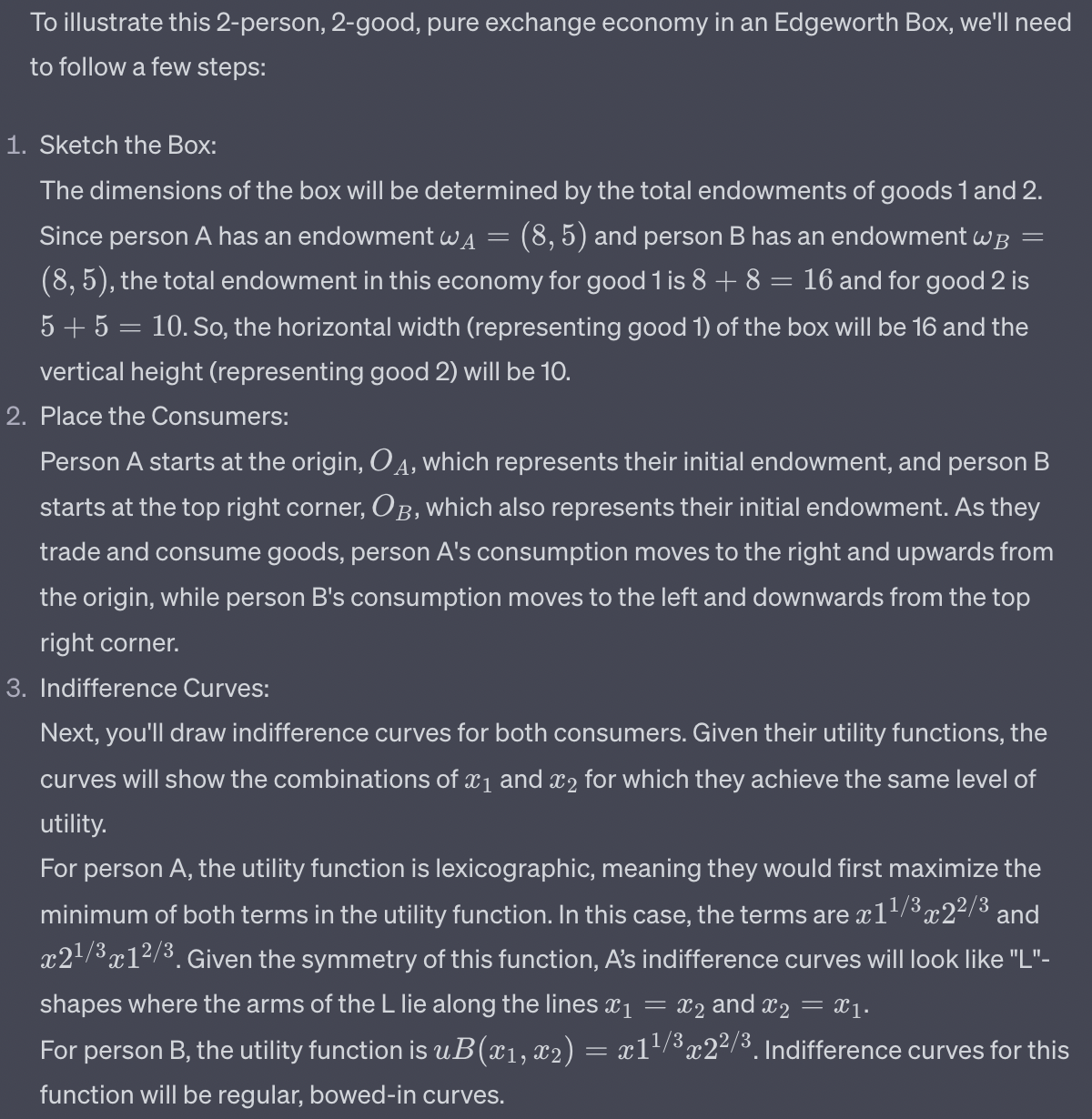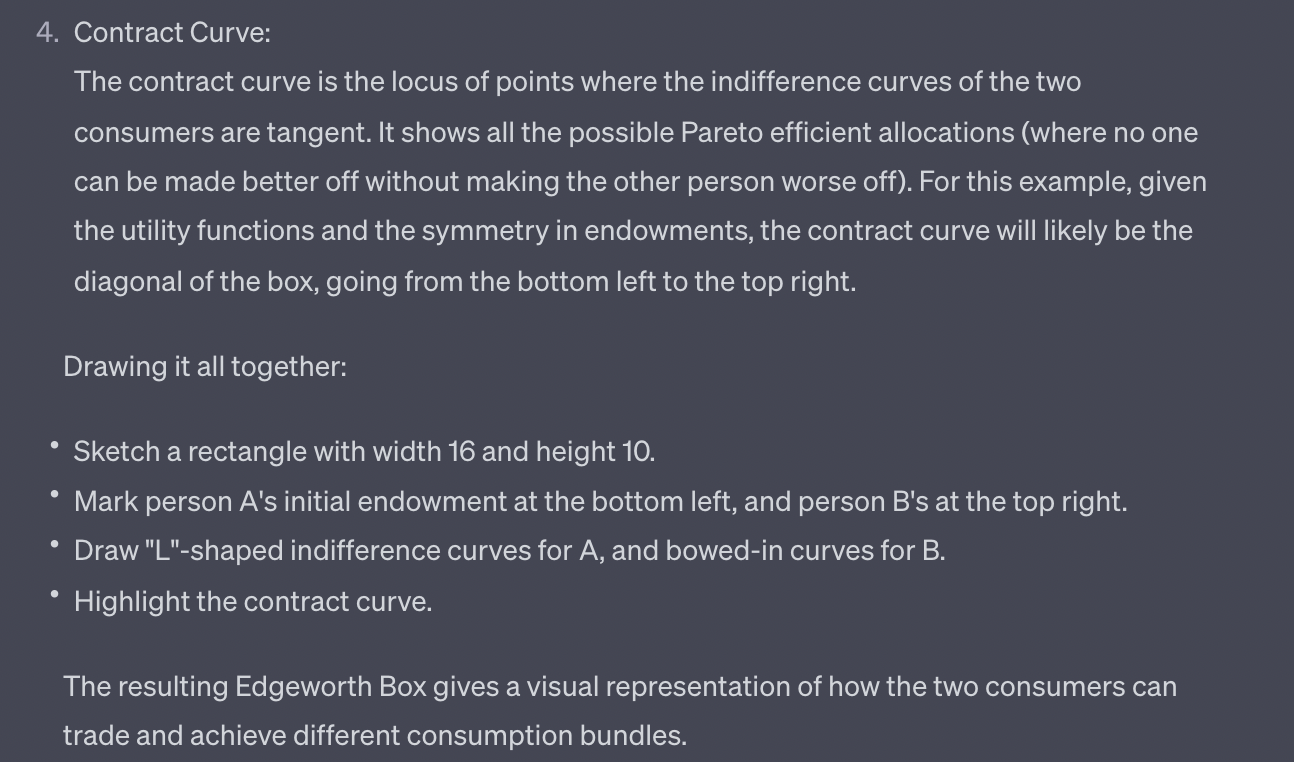Answered step by step
Verified Expert Solution
Question
1 Approved Answer
PLEASE USE THIS INFORMATION TO SKETCH THE GRAPH to follow a few steps: 1. Sketch the Box: The dimensions of the box will be determined


PLEASE USE THIS INFORMATION TO SKETCH THE GRAPH
to follow a few steps: 1. Sketch the Box: The dimensions of the box will be determined by the total endowments of goods 1 and 2 . Since person A has an endowment A=(8,5) and person B has an endowment B= (8,5), the total endowment in this economy for good 1 is 8+8=16 and for good 2 is 5+5=10. So, the horizontal width (representing good 1 ) of the box will be 16 and the vertical height (representing good 2) will be 10. 2. Place the Consumers: Person A starts at the origin, OA, which represents their initial endowment, and person B starts at the top right corner, OB, which also represents their initial endowment. As they trade and consume goods, person A's consumption moves to the right and upwards from the origin, while person B's consumption moves to the left and downwards from the top right corner. 3. Indifference Curves: Next, you'll draw indifference curves for both consumers. Given their utility functions, the curves will show the combinations of x1 and x2 for which they achieve the same level of utility. For person A, the utility function is lexicographic, meaning they would first maximize the minimum of both terms in the utility function. In this case, the terms are x11/3x22/3 and x21/3x12/3. Given the symmetry of this function, A's indifference curves will look like "L"shapes where the arms of the L lie along the lines x1=x2 and x2=x1. For person B, the utility function is uB(x1,x2)=x11/3x22/3. Indifference curves for this function will be regular, bowed-in curves. 4. Contract Curve: The contract curve is the locus of points where the indifference curves of the two consumers are tangent. It shows all the possible Pareto efficient allocations (where no one can be made better off without making the other person worse off). For this example, given the utility functions and the symmetry in endowments, the contract curve will likely be the diagonal of the box, going from the bottom left to the top right. Drawing it all together: - Sketch a rectangle with width 16 and height 10. - Mark person A's initial endowment at the bottom left, and person B's at the top right. - Draw "L"-shaped indifference curves for A, and bowed-in curves for B. - Highlight the contract curve. The resulting Edgeworth Box gives a visual representation of how the two consumers can trade and achieve different consumption bundles. to follow a few steps: 1. Sketch the Box: The dimensions of the box will be determined by the total endowments of goods 1 and 2 . Since person A has an endowment A=(8,5) and person B has an endowment B= (8,5), the total endowment in this economy for good 1 is 8+8=16 and for good 2 is 5+5=10. So, the horizontal width (representing good 1 ) of the box will be 16 and the vertical height (representing good 2) will be 10. 2. Place the Consumers: Person A starts at the origin, OA, which represents their initial endowment, and person B starts at the top right corner, OB, which also represents their initial endowment. As they trade and consume goods, person A's consumption moves to the right and upwards from the origin, while person B's consumption moves to the left and downwards from the top right corner. 3. Indifference Curves: Next, you'll draw indifference curves for both consumers. Given their utility functions, the curves will show the combinations of x1 and x2 for which they achieve the same level of utility. For person A, the utility function is lexicographic, meaning they would first maximize the minimum of both terms in the utility function. In this case, the terms are x11/3x22/3 and x21/3x12/3. Given the symmetry of this function, A's indifference curves will look like "L"shapes where the arms of the L lie along the lines x1=x2 and x2=x1. For person B, the utility function is uB(x1,x2)=x11/3x22/3. Indifference curves for this function will be regular, bowed-in curves. 4. Contract Curve: The contract curve is the locus of points where the indifference curves of the two consumers are tangent. It shows all the possible Pareto efficient allocations (where no one can be made better off without making the other person worse off). For this example, given the utility functions and the symmetry in endowments, the contract curve will likely be the diagonal of the box, going from the bottom left to the top right. Drawing it all together: - Sketch a rectangle with width 16 and height 10. - Mark person A's initial endowment at the bottom left, and person B's at the top right. - Draw "L"-shaped indifference curves for A, and bowed-in curves for B. - Highlight the contract curve. The resulting Edgeworth Box gives a visual representation of how the two consumers can trade and achieve different consumption bundlesStep by Step Solution
There are 3 Steps involved in it
Step: 1

Get Instant Access to Expert-Tailored Solutions
See step-by-step solutions with expert insights and AI powered tools for academic success
Step: 2

Step: 3

Ace Your Homework with AI
Get the answers you need in no time with our AI-driven, step-by-step assistance
Get Started


